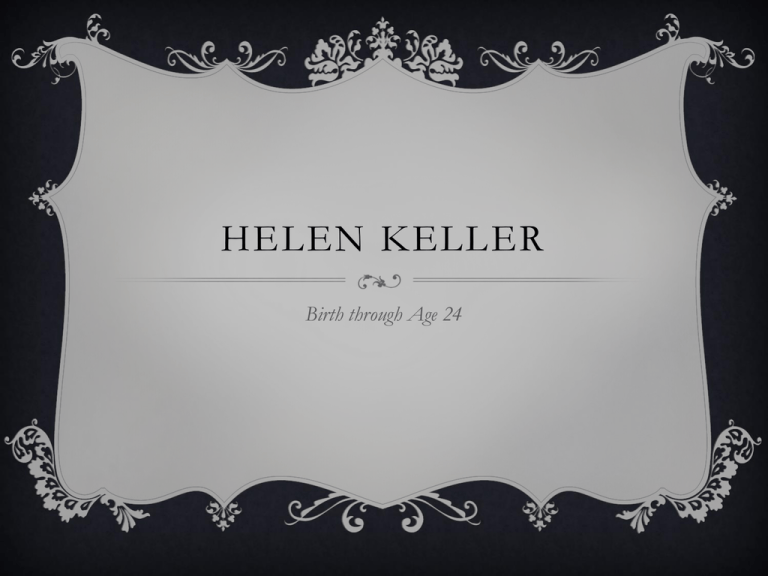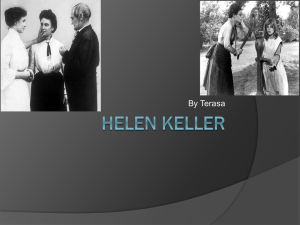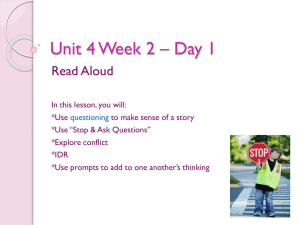Helen Keller - CCSS7thGradeEnglishMaterials
advertisement

HELEN KELLER Birth through Age 24 HELEN KELLER Helen Keller and Annie Sullivan CAPTAIN JAMES KELLER Captain Keller was a wealthy landowner and newspaper publisher. He came from a distinguished southern family. Captain Keller served in the Civil War and was quite respected by the residents of Tuscumbia. CAPTAIN JAMES KELLER Keller owned and edited his own weekly newspaper, the North Alabamian. Captain Keller was an avid hunter. After the death of his first wife, he married Kate Adams (whom was 20 years younger than Captain Keller.) KATE ADAMS KELLER While Captain Keller worked in his newspaper office in town, Kate tended the pigs, turkeys, chickens, and sheep that roamed their property. Kate enjoyed gardening and curing country hams. HELEN’S YOUNG LIFE Helen Adams Keller was born in Tuscumbia, Alabama on June 27, 1880. Helen was born with both sight and hearing. HELEN AS A BABY Helen was a very intelligent baby Her parents insisted that at the age of 6 months she could say “wah-wah” for water and “how do you do?” She took her first steps on her first birthday She gleefully ran to her father every evening to give him a welcome home kiss. HELEN’S ILLNESS In February of 1882, Helen The Keller’s were ecstatic suddenly became ill with a very when Helen’s fever broke, but high fever. Kate knew within days that The doctor’s diagnosis was Helen had lost her sight and “acute congestion of the hearing. stomach and brain” Helen’s brain was The prognosis was death. permanently damaged. QUOTE FROM HELEN KELLER “I was too young to realize what had happened. When I awoke and found that all was dark and still, I suppose I thought it was night and I must have wondered why day was so long in coming. Gradually, however, I got used to the silence and darkness that surrounded me, and forgot that it ever had been day. Soon even my childish voice was stilled because I had ceased to hear any sound.” H E L E N A T T E M P T E D T O. C O M M U N I C AT E W I T H H E R FA M I LY If she desired a piece of cake, she developed a gesture for beating the batter. Bread was signaled by making the motions of spreading butter and slicing. If she wanted ice cream, she imitated the turning of the ice cream’s freezer. As Helen grew and her vocabulary of signs expanded, her parents hoped something could be done to rehabilitate Helen. LAURA BRIDGMAN Laura Bridgman, the first known deaf and blind person to be educated, went to study at the Perkins Institute for the Blind when she was seven years old. The Kellers first learned of Bridgman after reading Charles Dickens’s American notes. LAURA BRIDGMAN Laura Bridgman and Annie Sullivan became friends while attending the Perkins Institute. Dr. Samuel Gridley Howe was famous for the work his did with Bridgman. ALEXANDER GRAHAM BELL The Kellers took Helen to Dr. Bell was a Scottish Baltimore to see a famous inventor. oculist, Dr. Chisholm, in 1886. He was particularly interested Although Dr. Chisholm could not help the Kellers, he suggested that the go see Dr. Alexander Graham Bell. in the deaf because both his mother and his wife were deaf. Bell’s father was a pioneer in deaf education, inventing “visible speech” DR. ANAGNOS Dr. Bell suggested that the Kellers write Dr. Howe’s successor at the Perkins Institute, Dr. Michael Agagnos. Dr. Anagnos immediately noticed the similarities between Laura Bridgman and Helen Keller. He felt that Anne Mansfield Sullivan would be just the person to teach young Helen. PREPARING TO TEACH Annie Sullivan spent 6 months studying Howe’s files on his work with Laura Bridgman. Sullivan was to be paid $25 a week for her job to teach Helen. In March of 1887 Annie took the long train ride to become Helen’s teacher. IVY GREEN The Keller Home Tuscumbia Alabama IVY GREEN The Cottage IVY GREEN DINING ROOM HELEN AND ANNIE After only 32 days with Annie Sullivan, Helen could communicate with others, express herself, ask questions and receive answers. LEARNING TO READ By the end of May Annie began to teach Helen to read letters using the raised letter alphabet . She then moved on to the simple raised letter books. Annie wrote to Perkins and requested personalized word cards for Helen with the names of Helen’s family and things in her environment. LEARNING TO WRITE By June Annie was teaching Helen to write. A writing board enabled her to say within even horizontal lines so that the worlds were uniform and legible to others. By guiding her write hand with her left, she reproduced the raised letters that she felt on the alphabet cards. Known as square-hand script, this form of writing was taught to students at Perkins. BRAILLE Soon after Helen’s 7th birthday, Sullivan began to teach her to read braille. Braille was invented by the Frenchman, Louis Braille , in the 1820’s. HELEN’S BRAILLEWRITER Helen first learned to write using a Braille stylus. She later aquired a six key device known as a Braillewriter, making writing much easier. HELEN FIRST VISIT TO PERKINS In May, 1888, Dr. Anagnos extended an invitation for Helen and Annie to visit The Perkins Institute. Mrs. Keller, Annie, and Helen took the trip together. Helen was visited with both Dr. Alexander Graham Bell and President Grover Cleveland. PERKINS Although Helen was never enrolled as a student at Perkins. She and Annie spent four winters there. Helen studied and had the opportunity to socialize with other blind children. PLAGARISM On the occasion of his birthday in November of 1891, Helens sent Anagnos a “little story which I wrote for your birthday gift.” Anagnos had the story published. Reports soon surfaced that claimed Helen’s story was not original. Anagnos arranged for a “trail” to take place at Perkins. Helen was questioned for two hours. Anagnos was the last vote to determine Helen “not guilty,” but later changed his vote to guilty. MARK TWAIN’S RESPONSE It was later determined that the story had been read to Helen three years earlier, but she had not remembered it. Mark Twain commented on the trial. “Oh, dear me, how unspeakably funny and owlishly idiotic and grotesque was the “plagarism farce!) W R I G H T- H U M A S O N O R A L S C H O O L FOR THE DEAF Dr. Alexander Graham Bell asked John Spaulding to pay for Helen to attend the Wright-Humason Oral School for the Deaf in New York City. Helen began in October of 1894. Annie Sullivan remained by her side. Helen attended the school for two years. Helen did very well in all of her studies, but was never able to speak and lip-reading entire sentences was difficult for her. Helen attended the Cambridge School for Young Ladies in Cambridge, Massachusetts. She began in September 1896. The school’s director, Arthur Gillman, felt Helen should remain at Cambridge for a third year. Annie Sullivan was against it. Gillman wrote to Mrs. Keller and told her Annie was working Helen too hard. Mrs. Keller named Mr. Gillman as Helen’s legal guardian. Gillman separated Helen and Annie. Annie wrote a telegram to Mrs. Keller stating “We need you.” Mrs. Keller immediately went to them and was outraged to find that Gillman had separated the two ladies. She immediately withdrew Helen from the school. Helen and Annie worked for two years with a tutor, Merton Keith, to help prepare Helen for college. In 1902 The Ladie’s Home Journal asked Helen to write the story of her life. The magazine paid Helen $3000. John Macy, a Harvard professor, agreed to edit the work, along with Sullivan’s help. The first installment was published and four more followed. 1903 – The articles were turned into a book called The Story of My Life. RADCLIFFE At the age of 20 Helen entered Radcliffe College. Annie continued to work with Helen and she graduated from Radcliffe at the age of 23. HELEN’S HOME With money from the sale of the book Helen and Annie purchased a 7 acre estate in Wrentham, Massachusetts. Helen said, “ I shall devote my life to those who suffer from loss of sight.”









